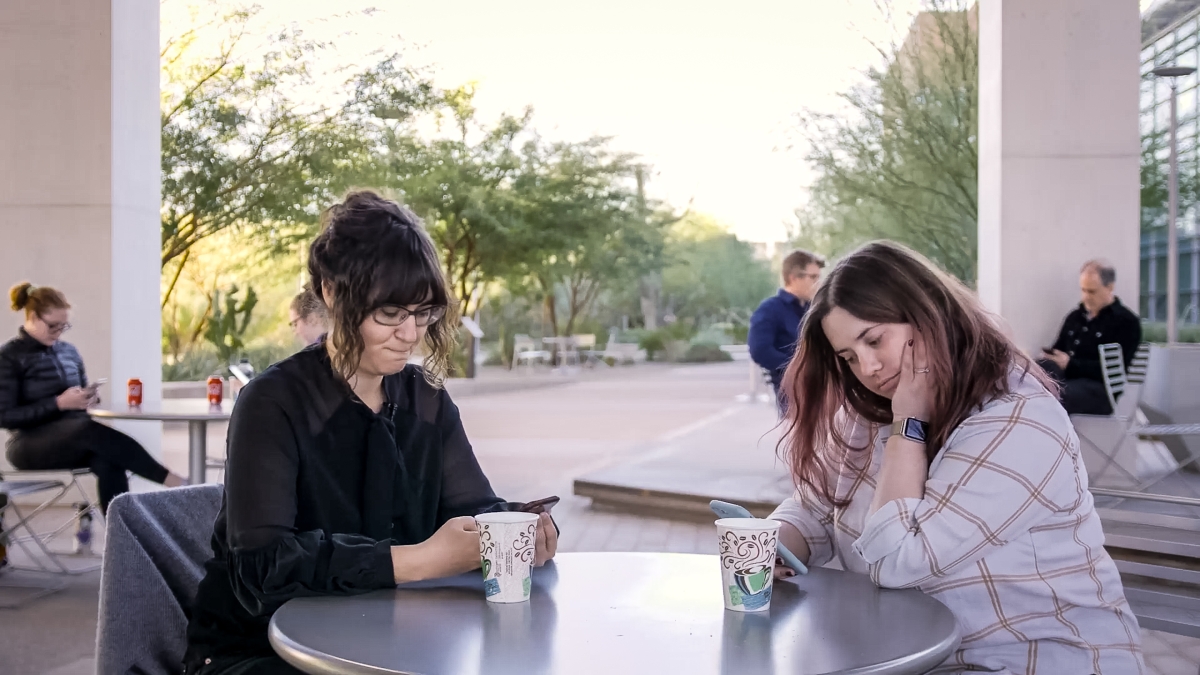Before the threat of the novel coronavirus sent us all home to shelter in place this spring, limiting our face-to-face interactions to just a few members of our immediate household (if we were that lucky), it seemed to many that humans as a species had begun to take for granted the myriad opportunities for in-person connection in favor of scrolling through social media and other entertainment via our smartphones.
ASU Associate Professor of psychology Athena Aktipis wanted to know if there was a way to get people to put down their phones and engage with the environment around them and the person sitting next to them. In a paper on the subject, Aktipis and colleagues explore the classic coordination problem from game theory: the stag hunt game.
According to the theory, individuals can either choose to work by themselves, hunting small game like rabbits, or they can choose to work together and potentially garner a larger payoff in the form of a stag. In this modern manifestation of the stag hunt game, scrolling through social media instead of engaging with people physically near you is like choosing to hunt rabbits on your own.
“We call it scrolling for metaphorical rabbits,” Aktipis said. “Essentially, with a stag hunt game, you can only get the bigger payoffs if you coordinate.”
This problem and ways to solve it, including developing an app that allows social contacts to opt in to a coordinated technology blackout, is discussed in the article by Aktipis and her collaborators, Roger Whitaker of Cardiff University in Wales, and ASU psychology graduate student Jessica Ayers.
ASU Now spoke with Aktipis about the study’s findings, revealing advice that is useful both for those who are eager to get back to socializing in person (hopefully at a safe distance and while wearing a mask), as well as those who are choosing to take it slow but might need some help setting aside their smartphone to have a real conversation with members of their quaran-team.
Question: If, in this modern manifestation of the stag hunt game dilemma, the smaller reward is the satisfaction you feel from scrolling through social media, what is the bigger reward of putting down your phone and engaging in face-to-face conversation?
Answer: This is something that is somewhat subjective, and I’ve had some interesting conversations with people about this. The minority would rather be on their phone than talking with their friend or spouse sitting next to them. But I think for a lot of us, having that very human interaction where we make eye contact, listen to each other’s voices, see each other’s facial expressions and are able to understand each other in a more nuanced way is something that really helps us to feel more human and more connected and supported in whatever it is that we’re experiencing. And if we just go with the safe option of being on our devices, we miss out on that.
Q: As a solution, you and your colleagues suggest an app that would allow social contacts to opt in to a coordinated technology blackout. Tell me more about that.
A: We’re working on developing that now. But I think right now, given the current situation, maybe there’s a unique chance to look at how it would work in smaller-scale situations, because people aren’t interacting with hundreds of people a day anymore; they’re interacting with their roommates or their families or the cashiers at grocery stores.
Q: Has the pandemic made you rethink any of the aspects of your study?
A: It’s kind of an exciting time, despite it being really a huge challenge for all of us as a society. But I think that there are certain parts of the changes that we’re undergoing that we’ll be able to actually take as an opportunity to reflect on what we value and how we want to live our lives intentionally in relation to other people and what role we want social media and smart devices to be playing in our social lives. Especially since that role is expanding now with the need to social distance. There are lots of benefits to being able to utilize technology for our social interaction. What we need to think about now is how much of it do we want to be scrolling through feeds versus having real conversations.
Q: As technology advances, we’re not just getting pings from our phones; we’re getting a buzz on our wrist or a sudden announcement from Alexa in the middle of our favorite song. What kind of challenges do you foresee there?
A: If instead of a smart device in your pocket, you have a watch on your person — or even an implant in your retina — as you go more and more invasive with the technology, the decision point for whether we want to keep interacting with the things around us or be tied to a feed coming in electronically is going to become much more important. Each of us will have to decide if we want to be tethered to people or to Google news alerts. And we’ll need to make those decisions intentionally, because if you just leave all your notifications on, your consciousness just gets flooded with all sorts of things you might not even value or prioritize.
Q: What do you think the need to shelter in place has revealed about humans' preferences regarding social interaction? And do you think those preferences will change?
A: I think the current situation has revealed an underlying preference for in-person interaction that maybe people didn’t consciously realize. When you take away the possibility of getting together with friends in person, you realize there’s something really valuable about that. And I don’t think that will ever go away no matter how advanced technology becomes. There’s just something fundamental about being in each others' physical presence. You can get a decent amount of that from the phone or other correspondence; people have had long-distance relationships from the beginning of recorded history. But almost always, those relationships intended to move toward a place where they could eventually get together in person. Fundamentally as humans, we are a very social species. We need social connections to feel normal. And I think right now, there is an opportunity for us to connect with the people who are closest to us in a deeper way.
Q: What else is going on in your life that you’d like to share?
A: The second season of my podcast Zombified is out now. In the final episode (which came out March 10), I talk with author and science communicator David Quammen about the origins of viral diseases and the stories behind how pandemics start and spread. He was so prescient about it, it was kind of creepy but also really cool. And then in between Season 2 and 3, we’re planning on doing a bunch of mini episodes about how life is changing with the pandemic.
Top photo: Screenshot of a video explaining the stag hunt game theory from the Cooperation and Conflict Lab. Video produced by Robert Ewing.
More Science and technology

New study finds the American dream is dying in big cities
Cities have long been celebrated as places of economic growth and social mobility, but new research suggests that their role in fostering opportunity has changed dramatically…

Ancient sea creatures offer fresh insights into cancer
Sponges are among the oldest animals on Earth, dating back at least 600 million years. Comprising thousands of species, some with lifespans of up to 10,000 years, they are a biological enigma.…

When is a tomato more than a tomato? Crow guides class to a wider view of technology
How is a tomato a type of technology?Arizona State University President Michael Crow stood in front of a classroom full of students, holding up a tomato.“This object does not exist in nature,” he…


